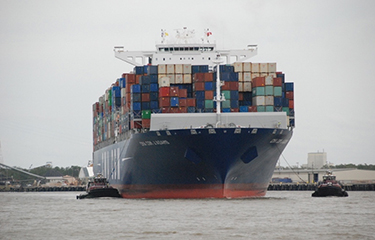A detailed analysis shows that speed limits for ships have reduced risk for collisions with endangered right whales, but there are significant gaps in compliance – particularly off U.S. Southeast ports, where burgeoning cargo traffic is on a long-term upswing, the National Oceanic and Atmospheric Administration (NOAA) reported.
Drafted in June and released on 21 January, the NOAA review used automatic identification system (AIS) data to track total vessel transits through the two types of speed limit zones: Seasonal Management Areas (SMAs), frequented by whales at known times of year where ships over 65 feet in length are mandated to make way at 10 knots or less; and dynamic management areas (DMAs), where NOAA issues temporary advisories to mariners to voluntarily observe the 10-knot limit when whales have been reported.
Ship strikes and entanglement in fishing gear are pressing threats to the right whale population – now estimated at less than 400 animals – and accounted for at least 86 serious injuries or deaths in U.S. and Canadian waters between 2000 and 2017, according to the report.
In 2008, the National Marine Fisheries Service implemented the seasonal, mandatory vessel speed rule in certain areas.
“While it is not possible to determine a direct causal link, the number of documented vessel strike mortalities and serious injuries decreased from 12 during the 10 years prior to the rule’s implementation to eight of the 10 years since implementation,” the report said. “This overall decline demonstrates progress but also indicates additional action is warranted to further reduce the threat of vessel collisions.”
Mariners’ compliance with the speed rule hit the highest level of 81 percent of vessel transits during 2018-2019. In most SMAs, more than 85 percent of large vessels maintained speeds under 10 knots. But compliance was low in some areas – below 25 percent outside Atlantic ports in the Southeast states from the Carolinas to Florida.
“Compliance has generally leveled off over the past few years and a significant amount of vessel traffic continues to transit active SMAs at speeds in excess of 10 knots,” the report said. “Compliance is generally higher in the four most northern SMAs and particularly excessive vessel speeds (greater than 12 knots) are an issue in the North Carolina to Georgia SMA.”
The region includes Charleston, South Carolina and Savannah, Georgia, where state port authorities and the U.S. Army Corps of Engineers have been working to expand capacity and deepen channels to as far as 55 feet to accommodate the new classes of container ships transiting the widened Panama Canal.
Those “post-Panamax” vessels, at 1,200 feet in length and carrying 14,000 or more shipping containers, began calling at those ports in 2017. From 2011 through 2018, Savannah’s container volume grew by 45 percent, and Georgia port planners are betting big expansion of cargo rail service can help them capture even more international trade.
It’s a similar story in Charleston, South Carolina, where container volume has nearly doubled since 2010; the port is nearing completion of a 52-foot channel deepening and will be capable of handling four post-Panamax ships at the same time.
Waters off those ports are traveled by migrating right whales, including pregnant females headed for winter calving grounds off Georgia and Florida.
“Requiring vessels to slow down is the least we can do to help save this iconic species,” Whitney Webber, a campaign director with the environmental group Oceana, which in March 2020 published its own AIS study showing widespread non-compliance with voluntary speed limits among ships transiting DMAs in the Northeast, said. “Studies have found that slowing speeds to 10 knots or less in areas where these whales may be encountered can reduce the risk of death by 86 percent.”
Among its recommendations the report calls for:
- Modifying SMAs to update them with latest knowledge about whale distribution and vessel traffic patterns.
- Consider declaring the area south of Martha’s Vineyard and Nantucket, Massachusetts, a SMA. The region accounted for at least 25 percent of DMA advisories over the last 10 years and right whales increasingly forage in the area.
- Three significant vessel collisions have occurred in the area around Cape Cod, Massachusetts, including at least one mortality inside an active SMA. This is an area of particular concern and requires a reassessment of management actions required to reduce the risk of vessel strikes there.
- NMFS should look at changing its regulatory language, and possibly require electronic notification when vessel operators exceed 10 knots for safety deviations.
- Ships in certain SMAs exceeding 10 knots at disproportionately high levels, in channel entrances to ports in the U.S. South under pilotage, represent an outsized proportion of vessels traveling at excess speed.
- Additionally, container ships and pleasure vessels disproportionately operate at speeds in excess of 12 knots. Enforcement and outreach targeted to these industry sectors is needed to ensure compliance and meaningful vessel strike risk reduction across all vessel types.
- NMFS must deal with vessel strike risk from boats under 65 feet, now exempt from speed limits. Small craft are ubiquitous in right whale habitat and there are enough documented and reported collisions to require new actions – as Massachusetts did in 2019 when it imposed a season speed limit on all vessels in Cape Cod Bay.
Reporting by Kirk Moore
Photo courtesy of Kirk Moore







